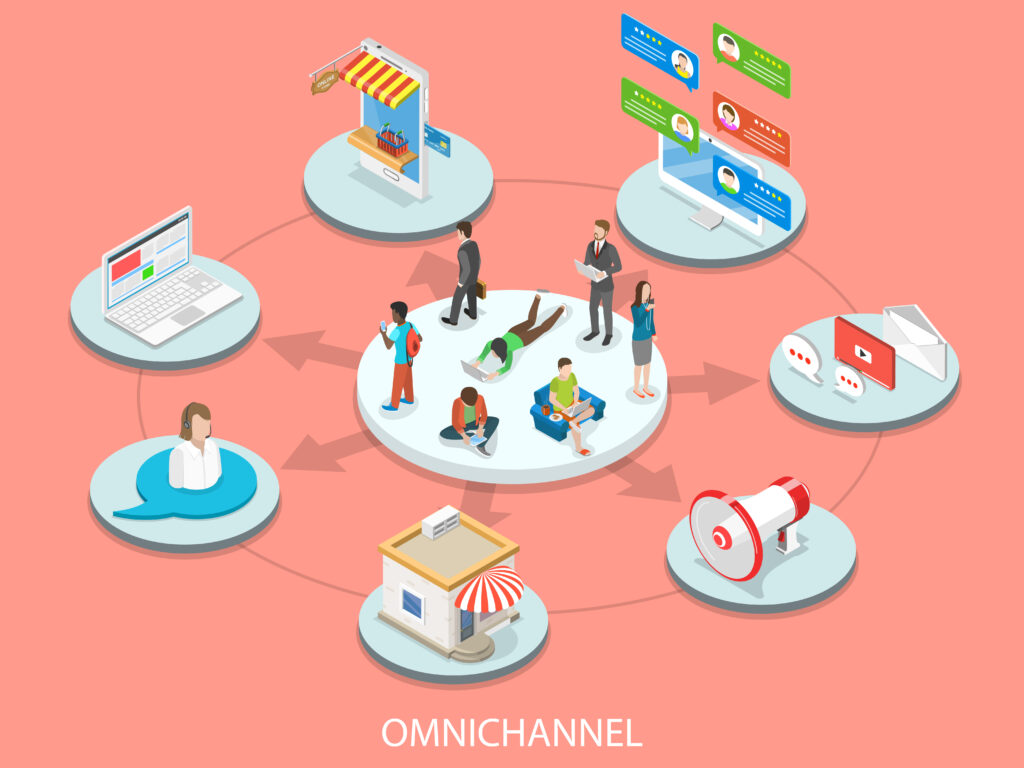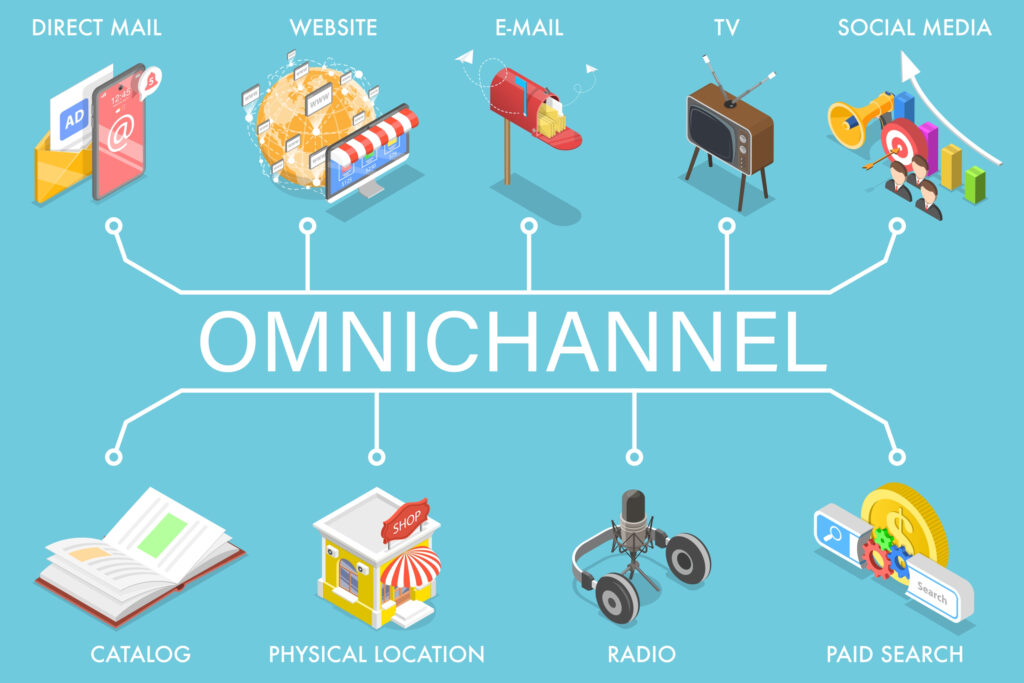LogiCommerce is trusted by global enterprise brands and wholesalers, across industries
Omnichannel eCommerce is a sales strategy that considers the many channels used today to reach customers.
By implementing an omnichannel strategy, companies can offer their customers seamless access to their products and services, regardless of the device they use. Omnichannel has become essential as consumers use more and more channels to make purchases. With the increased use of digital media, users consult multiple channels simultaneously during their purchasing processes, making it necessary for companies to implement omnichannel strategies to meet the needs and expectations of their customers.
Contents
Omni-channel is crucial to the success of eCommerce nowadays. Consumers expect brands to deliver a seamless and consistent shopping experience across multiple channels, including physical stores, mobile devices, online platforms, social media and more. By enabling customers to purchase products anytime, anywhere, regardless of the device used, companies can significantly improve their reach and meet the evolving needs of their customers.
The omnichannel strategy not only allows customers to shop from wherever they want, whenever they want, but also gives companies the opportunity to access additional data about their customers and use these insights to deliver fully personalized shopping experiences. Even recently, new platforms such as visual-based social networks have achieved even higher conversion rates than traditional eCommerce platforms.
These innovations offer both shoppers and businesses opportunities and advantages that were previously unavailable to them. To take full advantage of what omnichannel strategies can offer, companies must not only focus on engaging customers across multiple channels, but also adjust their tone of voice to each platform to get the highest rate of return.

The first benefit of an omnichannel strategy is the greater reach a company can have. By being present on different channels, such as physical stores, websites, mobile apps, social networks and Marketplace, it is possible to reach wider and more diverse audiences. It is important to note that it is not enough to be present on all channels simply for the sake of being there, but it is much more important to analyze which channels are most used by your target audience and then choose which channels you want to use.
For example, if a company only has a physical store in a limited geographical area, its reach will be much lower than that of a company that also has a presence online and on social networks. By having multiple points of contact with potential customers, you can create more opportunities to attract new customers.
Moreover, an omni-channel presence also allows companies to better adapt to customers' shopping preferences. Some customers prefer to shop at an eCommerce store from the comfort of their homes while others prefer to visit a physical store. By offering options for both types of shoppers (and others), companies are more likely to meet the unique needs and preferences of each customer.
A second benefit of an omnichannel strategy is that it enables you to deliver a smooth and seamless shopping experience across all channels.
Today's customers expect to be able to purchase products anytime, anywhere, regardless of the device used. If a company only offers a product on its website, for example, users will have to make the effort to access it to purchase the desired product. On the other hand, if a brand is present in those channels most used by its customers, such as social networks in most cases, and sells its products also through that channel, it will be easier for the user to end up betting on your brand.
Keep it in mind! The most important thing about an omnichannel strategy, is that the customer can move through the different channels in a coherent way; if a customer is browsing Instagram and accesses your brand profile where he will find the store in that same social network, it is important that, from there, he can go directly to your brand's website, make the purchase, receive information in his email and pick up the order in physical store if that is how it is requested. In this way, we understand that it is essential in an omnichannel strategy that the customer can navigate smoothly through any sales channel without encountering limitations or malfunctions.

Personalization is a key element in the omnichannel strategy and is achieved through the collection of customer data across different channels. By collecting information about customers' shopping behavior, preferences and needs, companies can deliver a more personalized and relevant experience for each customer.
For example, if a customer has purchased specific products from your online store, you can use this information to send them similar or complementary product recommendations via email. You can also use the information collected to offer personalized promotions that are relevant to the customer's interests.
By having access to detailed customer data, companies can tailor their offers to the specific needs of each customer. For example, if a customer prefers to shop online, but needs help choosing the right product, your eCommerce could offer chatbots or virtual assistants to help guide them through the entire process.
Customer loyalty is one of the main objectives of any business. An omnichannel strategy can help achieve this goal by delivering a satisfying and personalized experience across all channels.
When customers have a satisfying and personalized experience, they are more likely to return and make repeat purchases. Also, if they feel valued and cared for by the company, they may also recommend it to friends and family, which helps increase the customer base.
The omnichannel strategy allows companies to interact with customers at multiple touch points, which means they can offer a higher level of customer service. For example, if a customer has a problem with a product purchased from your eCommerce, they can contact customer service by phone or chat for help. Alternatively, if they prefer to visit a physical store, they can do so for in-person assistance.
Furthermore, companies can use the information collected about customers to offer personalized promotions or incentives for repeat purchases. This can increase customer loyalty and encourage customer engagement with the brand.
Implementing an omnichannel strategy can significantly improve a company's operational efficiency. By having an integrated system that enables the management of multiple channels, costs associated with maintaining non-integrated systems and platforms can be reduced.
Prior to the adoption of an omnichannel strategy, companies often used different systems to manage each channel. For example, one system for online sales and another for physical store sales. This resulted in duplication of effort, lack of synchronization between systems and inefficient processes.
By having an integrated system that allows centralized management of multiple channels, companies can avoid these problems. Orders placed by customers are consolidated in one place and can be managed from there. And by having a single customer database, the need to maintain separate information for each channel is avoided.
LogiCommerce is a fully unified B2B & B2C eCommerce platform that provides state-of-the-art technology at a very competitive cost. With its intuitive BackOffice, you will be able to simplify the daily operations of your eCommerce by unifying all your online and offline sales channels in a single intuitive and easy to use Control Panel.
Want to take a look? Ask for a free DEMO and discover LogiCommerce in 5 minutes.
